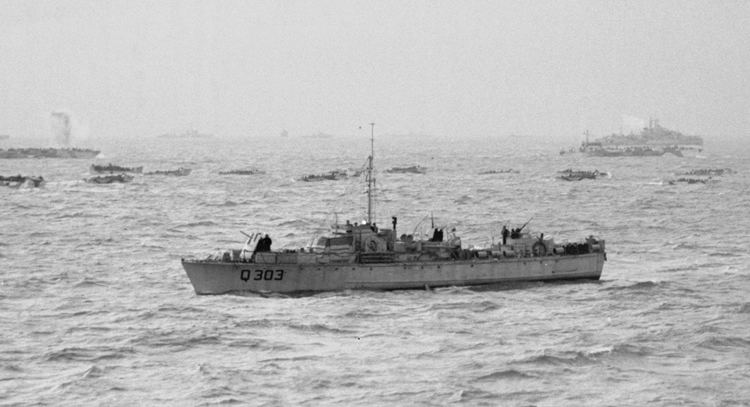Completed 650 approx. Length 112 ft (34 m) | Displacement 85 tons | |
 | ||
Name Fairmile B motor launch Succeeded by | ||
The Fairmile B motor launch was a type of motor launch built by British boatbuilder Fairmile Marine during the Second World War for the Royal Navy for coastal operations.
Contents
Design
While the Type A had been designed entirely by Fairmile, the Type B design had come from Bill Holt of the Admiralty based on the lines of a destroyer hull and the detailed design and production was taken on by Fairmile.
Like all their designs it was based on total prefabrication so individual components could be contracted out to small factories for production and these arranged as kits that would be delivered to various boatyards for assembly and fitting out.
Altogether approximately 650 boats were built between 1940 and 1945. Like the A Type, the B Type were initially intended as submarine chasers, so the boats were fitted with ASDIC (sonar) as standard. Their main armament initially reflected their anti-submarine focus, with 12 depth charges, a single QF 3-pounder Hotchkiss gun aft, and one set of twin 0.303-in machine guns. The specifications given are for the original 1940 British version. As the war moved on, the vessels were adapted to other roles and the armament was modified and upgraded such as the replacement of the 3 pounder with one or more 20 mm Oerlikon cannon and removal of the ASDIC dome for more clearance as minesweepers. Some boats were configured as motor torpedo boats.
Service
The first Fairmile B motor launch was completed in September 1940, with a further 38 from the first two production batches entering service before the end of the year.
All boats were essentially the same, although they could be adapted to serve in several roles by the expedient of having pre-drilled rails on their decks spaced to allow the fitting of various types of armaments. Although their armament initially reflected their main anti-submarine mission, nine of them were fitted with 21 inch torpedo tubes taken from ex-US Town-class destroyers; they formed the 2nd ML Flotilla tasked with anti-invasion duty, until the threat had passed.
During the Siege of Malta, they were used to sweep a narrow channel ahead of heavier minesweepers which widened the channel. The heavier minesweepers were initially the remnants of the Malta trawler force, then fleet minesweepers that arrived with a convoy from Gibraltar. The launches were able to pass over the mines whereas many trawler losses had been caused by the leading ship hitting a mine. A number served in the St Nazaire Raid as assault transports, but their light construction meant that they suffered heavily; 12 B motor launches were lost in the action, out of 16 deployed. Many were built as rescue motor launches with small sickbays aft of the engine room coaming,and classified as RML (Rescue Motor Launch). These were numbered in the series RML492 to RML500,and RML511 to RML553. Several more were converted to use as War Office ambulance launches with larger sickbays.
At least two were built in the British colony of Bermuda, home to the dockyard and Admiralty house of the North America and West Indies Station, by what was to become Burland, Conyers & Marirea, Ltd.
Canada built 80 boats. These were built in 13 different boatyards to slightly different specifications and used as escort vessels. Eight of these (ML392-399) were built by Le Blanc for the Royal Navy. These eight boats were transferred under Lend-Lease to the US Navy, because US coastal protection had been depleted by transferring ships to the Royal Navy for convoy work. The US Navy used them as submarine chasers (SC1466-1473) until their forces could be built up. There are two surviving examples on the west coast of Canada serving as party charter vessels.
New Zealand built 12 boats. These were used in New Zealand waters and around the Solomon Islands, and included HMNZS Maori and Kahu.
In Australia 35 boats entered service from October 1942. They were employed on routine patrols, convoy escorts, running special forces in and out of Japanese-held areas, boom defence patrols in harbours at home and abroad, courier operations, survey work, and raiding Japanese-held coasts.
At least six boats (ML380-383,829 and 846) were built by South Africa and commissioned during November 1942. These were sent as the 49th Fairmile Flotilla (SANF) to Burma and deployed along the Arakan coast. The boats saw much action in support of ground forces and disrupting Japanese supply lines.
The Imperial Japanese Navy salvaged two that had been sunk and placed them in service.
A number of boats were built in Egypt by Thomas Cook & Son, who had a Cairo shipyard for constructing Nile tourist craft. Armament was fitted in Port Said. The first three to enter service in 1942 were MLs 355, 353 and 348.
Post war they were often taken on as pleasure boats and a number of Fairmile Bs are on the National Register of Historic Vessels.
Fourteen Fairmile B were operated by the Italian Guardia di Finanza naval service, between 1947 and the 1980s.
Four currently survive in the UK, two of which are in excellent condition. One is RML497. Many others of the type are known to survive around the world, some still in commercial service as tour boats.
